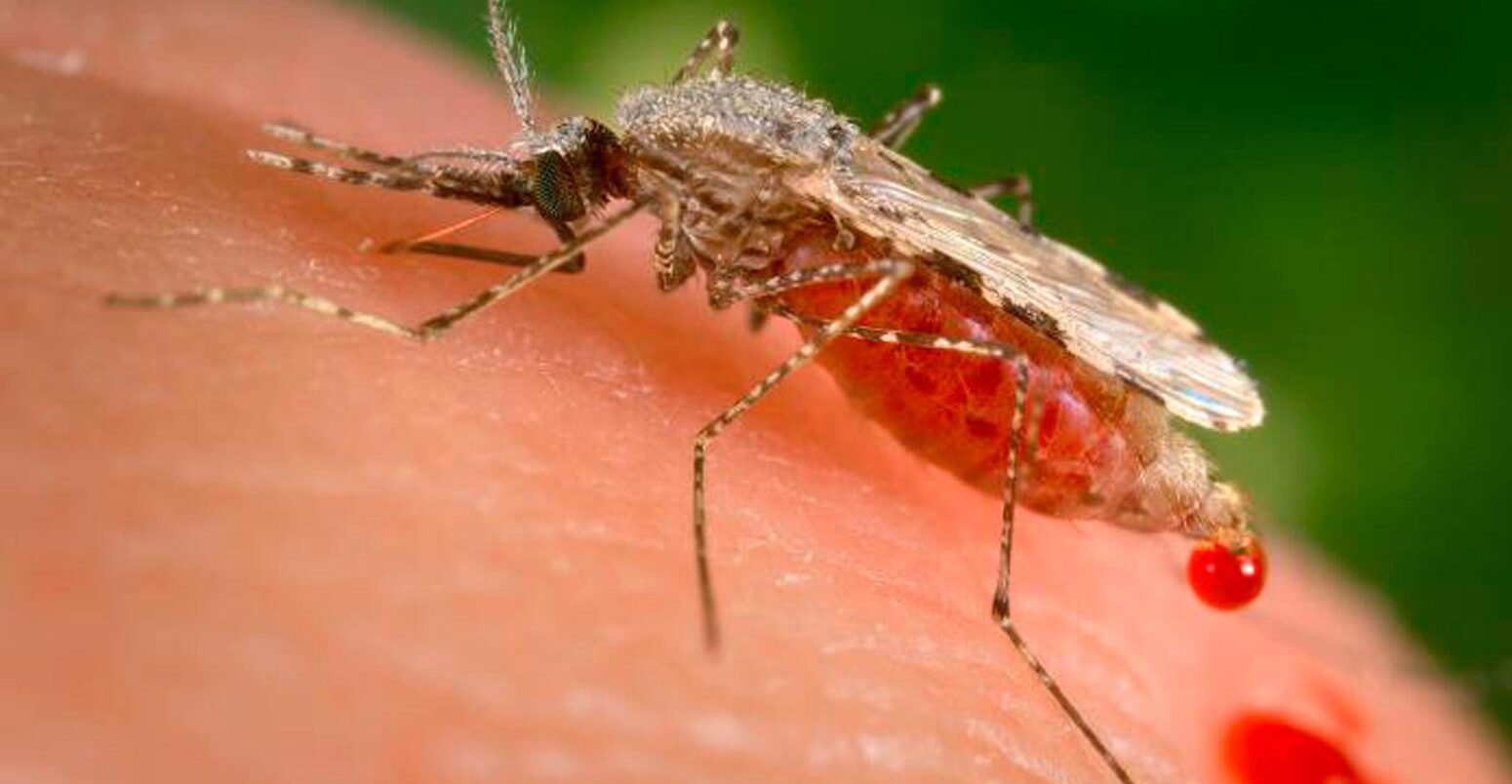
‘Malaria resurgence’ feared in Ethiopia amid El Niño and climate change
Ayesha Tandon
07.14.23Ayesha Tandon
14.07.2023 | 12:32pmScientists are concerned that this year’s El Niño event, combined with warming from climate change, could cause a rise in malaria cases in Ethiopia.
Malaria is a life-threatening disease that affects hundreds of millions of people every year.
More than 95% of all recorded malaria infections are in Africa where the hot and humid climate is ideal for the mosquitoes that transmit the disease.
Outbreaks of malaria are strongly linked to the climate. Global warming allows the disease to encroach on high altitude areas, for example.
Now, new research finds that malaria outbreaks in Ethiopia often follow El Niño events – natural cycles of variability that periodically bring hot weather to the country.
As the world leaves a rare “triple-dip” La Nina and enters an El Niño for the first time in years, the lead author of the study tells Carbon Brief that he “fears” another malaria outbreak could be imminent.
This comes as other research finds that “extreme” El Niño years will become more frequent with climate change.
He says high-quality climate data can help the government and local communities to prepare for malaria outbreaks and combat the disease more effectively. This includes selecting appropriate insecticides and distributing sleeping nets to the regions that need them most.
The burden of malaria
Malaria is a serious, often life-threatening, disease transmitted to humans by bites from infected mosquitoes. In 2021, the disease killed more than 600,000 people.
However, malaria is both preventable and treatable.
Global mortality from malaria declined by 90% over the 20th century. A total of 42 countries have eliminated the disease entirely through measures including insecticide use, draining the swamplands that mosquitos use for breeding, and improving basic healthcare services.
Today, the vast majority of malaria cases and deaths are recorded in Africa. The graphic below shows malaria deaths by world region for 1990-2019, with Africa shown in dark blue.
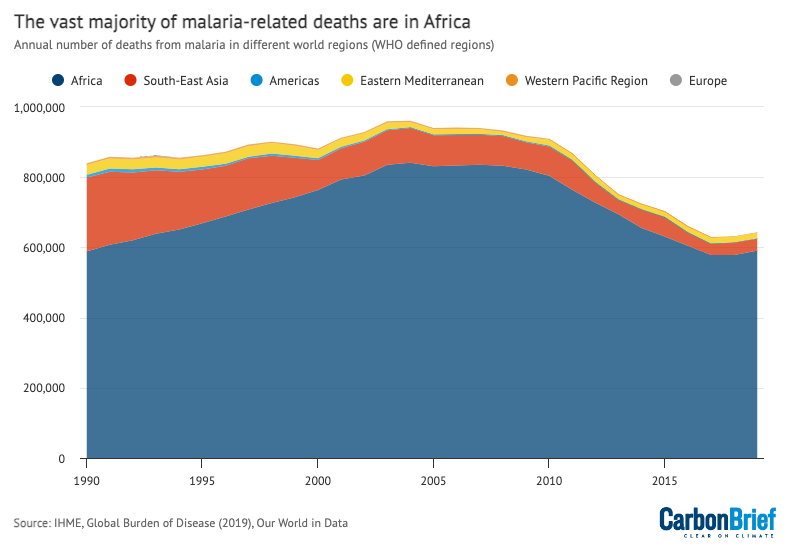
Mosquitoes thrive in high temperatures of around 29C and need stagnant or slow-moving pools of water to lay their eggs in.
Ethiopia is a tropical country, which has the climatic conditions needed for mosquitoes to thrive. The country ranks in the top fifteen globally for malaria cases and deaths.
The graphic below shows deaths from malaria in Ethiopia for 1990-2019.
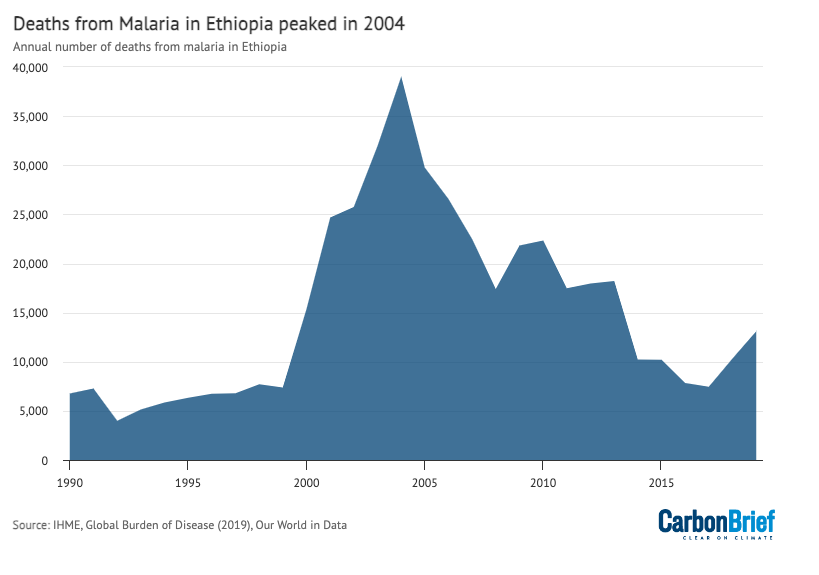
El Niño
Ethiopia has two rainfall seasons. The main rainfall season, known as Kiremt, runs from June to September and accounts for 50-80% of the country’s annual rainfall. The shorter rainy season, known as Belg, starts in February.
Intense rainfall creates pools of water that can provide the ideal breeding spot for mosquitos. Malaria cases across Ethiopia typically peak between September and December, following the main rainy season. The shorter rainy season also sometimes triggers a period of malaria transmission.
The authors of the study use monthly climate data from Ethiopia’s National Meteorological Agency to assess maximum and minimum daily temperatures, sea surface temperatures and rainfall patterns across the country from 1981-2016.
Rainfall patterns in Ethiopia are strongly influenced by El Niño – a weather phenomenon that originates in the Pacific Ocean but affects the entire world. Every five years or so, a change in the winds in the equatorial Pacific impacts ocean circulation patterns in the Pacific Ocean, driving up temperatures and changing rainfall patterns across the globe.
The authors find that El Niño events are “strongly” linked to high maximum temperatures across the country, drought in north-west Ethiopia during the long rainy season and “unusually heavy rain in the semi-arid south-east” during the short rainy season. El Niño’s counterpart – known as La Niña – has the opposite effect, they find.
Together, El Niño and La Niña are known as the El Niño Southern Oscillation (ENSO) and are a key global driver of natural climatic variability.
The authors conducted a literature review to determine when and where malaria outbreaks hit the country from 1950-2014. By assessing peer reviewed and “grey literature”, including reports and government documents, they identified 36 country-wide outbreaks– or “epidemics”.
By comparing climate and malaria data, the authors conclude that malaria epidemics frequently occur after El Niño events, while fewer epidemics are seen in the aftermath of La Niña events.
Dr Adugna Woyessa is a senior researcher at the Ethiopian public health institute and lead author on the new study. He tells Carbon Brief that as the planet enters an El Niño phase for the first time since 2016, he “fears” another malaria epidemic could be imminent.
Furthermore, research suggests that, as the climate warms, “extreme” El Niño years – defined by the size of the rainfall shift from the west Pacific over to the normally dry east Pacific – could become more frequent. If global warming reaches 1.5C above pre-industrial levels, extreme El Niño events could happen twice as often as in a preindustrial climate, the study finds.
Dr Tarekegn Abeku, a researcher at the Malaria Consortium and who was not involved in the study, tells Carbon Brief that the study is “an important addition to the body of knowledge on the impacts of extreme climatic events on human health”. He adds that it confirms the findings of his own work on the links between temperature anomalies and epidemics in Ethiopia.
However, Abeku warns that there are “a few methodological and data issues” in the study. For example, he points to the way that the authors link the climate and malaria data:
“The paper relies on correlation analysis which may not be suitable to study phenomena such as the complex relationships of climate variables and malaria transmission. It is known that temperature or rainfall and malaria incidence have a non-linear relationship.”
Limiting factors
The climate of Ethiopia is “extremely complex because of its varied topography and geographic location,” according to the study. This means that there are different “limiting factors” on malaria transmission in different regions, Woyessa explains.
For example, malaria outbreaks in Ethiopia are typically rare in the highland areas because the night-time minimum temperatures at high altitudes are too low for mosquitoes. The country’s national malaria programme uses 2km as the cut-off altitude for deploying malaria control tools.
In the highlands, temperature is the limiting factor and any increase in temperature – such as that during El Niño events – may allow malaria to spread to higher altitudes, Woyessa says.
Literature shows that warming caused by climate change allows the disease to encroach on high altitude areas and lengthens the annual period of “malaria suitability” in the African highlands.
When malaria reaches higher altitudes, the local communities are often unprepared and have low immunity. This was seen in the early 2000s when malaria outbreaks occurred in towns and villages as high as 2.5km in altitude.
In the lowlands of Ethiopia, rainfall is often the limiting factor, explains Woyessa. However, El Niño can reduce rainfall across parts of the country during the long rainy season, causing rivers to dry up into small pools that are ideal for the transmission of malaria.
‘Complex’ climate
The authors also conducted research on Amhara – a region of Ethiopia with a population of about 20 million people and the greatest number of reported epidemics. Amhara is shown on the map of Ethiopia below.
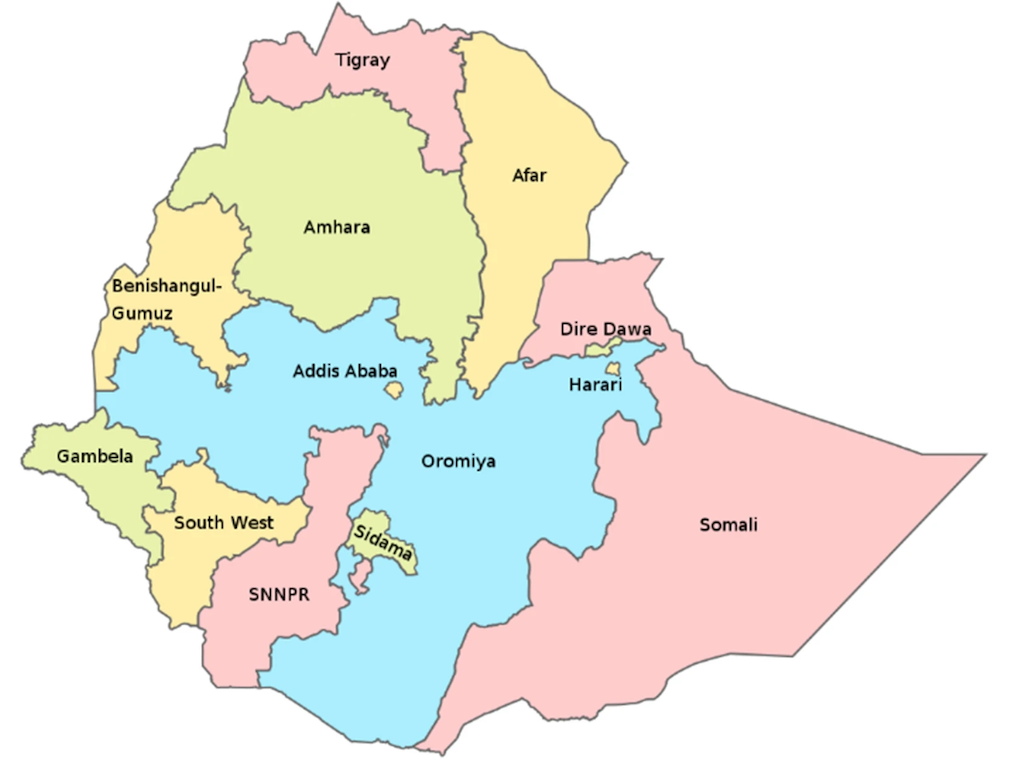
Woyessa tells Carbon Brief that Amhara has “high rainfall overlapping with low elevation”, which are required by mosquitoes to live and reproduce.
The authors find that average temperatures in Amhara have increased in recent decades, with many of the hottest years occurring during El Niño events. The warming trends in Amhara are “consistent with observed and predicted warming associated with climate change in Ethiopia and the East African region”, the authors say.
The results in the Amhara region are complex, however. The authors find that “local and widespread epidemics were associated with every phase of ENSO in Amhara”. This means El Niño events cannot be used as a predictor of malaria outbreaks in the region.
Instead, the authors suggest a relationship with the warming Atlantic Ocean. Their data suggests that warm tropical Atlantic sea surface temperatures and higher rainfall are “weakly associated with elevated malaria epidemic risk” following the long rainy season.
Differences at a local level are due to diversity of the country’s topography and corresponding climate, Woyessa explains, and more research may be needed to understand the predictors of malaria outbreaks in the Amhara region.
He tells Carbon Brief that “for us to have a concrete understanding of the climate and its influence on malaria we have to have quality data at a local level below the region”.
In the meantime, the relationship between past El Niños and malaria outbreaks at a national scale provides valuable hints for how to better prepare for future events, Woyessa explains.
Dr Cyril Caminade – a researcher at the University of Liverpool’s institute of infection, veterinary and ecological sciences who was not involved in the study – has conducted research on the impacts of climate change on global malaria distributions.
He tells Carbon Brief that it can be challenging to separate out the effects of interannual variability – for example, ENSO – with long-term trends from climate change as “these effects act in synergy for East Africa and Ethiopia”.
However, he says that, “overall, climate change might lengthen the potential length of the malaria transmission season in Ethiopia”.
Data challenges
Producing and accessing high-quality climate data across Africa is a long-standing problem.
Lack of funding and resources, as well as political and technical constraints, means that researchers across the continent often lack the quality and volume of data that they need.
The authors of the study say that identifying malaria epidemics using grey literature has “considerable weaknesses” as a method, as there is no clear definition of an epidemic to use in the search and biases in reporting could mean some epidemics are missed.
Caminade notes the limitations in using grey literature to assess malaria epidemics, acknowledging that literature reviews are “always time consuming and complicated”.
Conversely, climate data for this project was readily available from the Enhancing National Climate Services Initiative (ENACTS) – a project led by the International Research Institute for Climate and Society.
This database is a good example of “a user-friendly national climate database that can be used for climate analysis, epidemic early warning, and other responses to climate change as part of national adaptation plans to counter the adverse effects of extreme weather events”, Abeku tells Carbon Brief.
Woyessa tells Carbon Brief that the service has been “helpful for health professionals to understand the duration of malaria transmission in their area”. He adds:
“Understanding the climate of the area is very, very important for us to do the planning of intervention and the time at which they reach the peak and the time at which we have to do the intervention before the transmission begins.”
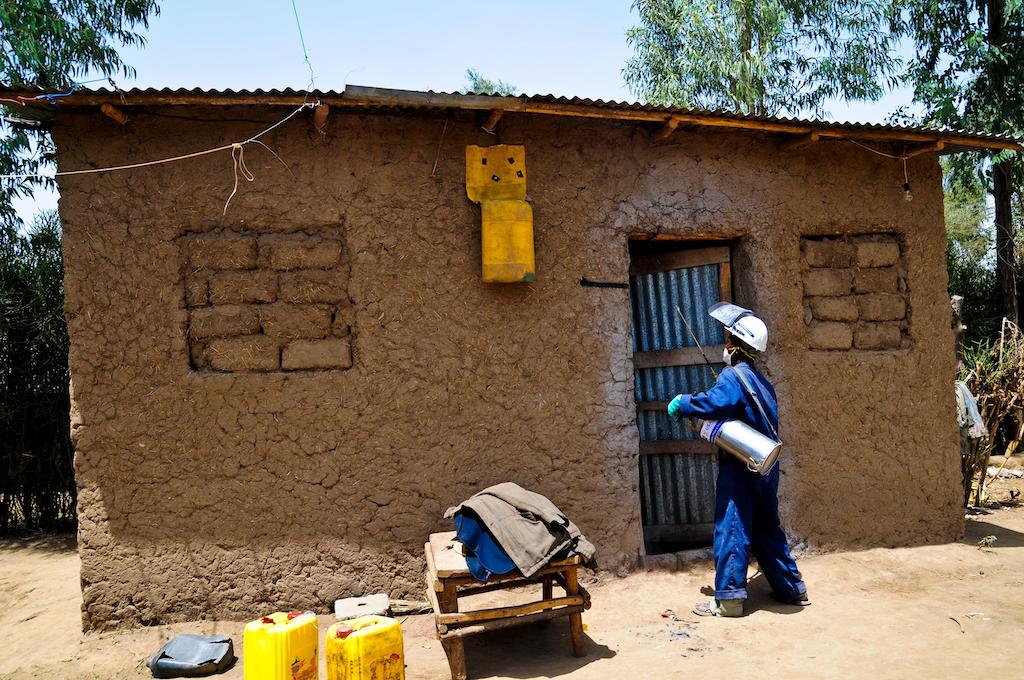
For example, he tells Carbon Brief that Ethiopia has a “long history of drought”. Drought can cause problems – such as crop failure – that make people more vulnerable and put them at greater risk of dangerous malaria infections, he says.
The paper says that the 2002-03 malaria epidemic in Ethiopia, which killed tens of thousands of people, was partly due to a prolonged drought:
“A two-year drought, and consequent low anti-malaria immunity alongside high levels of malnutrition likely paved the way for the 2002 and 2003 epidemic. It was a shocking epidemic in which WHO estimated up to 15 million of the then 65 million population were affected: a three-fold increase from the normal caseload.”
Temperature and rainfall are not the only factors influencing the frequency of malaria outbreaks. For example, the authors also point to recent “funding hiatus” in malaria prevention efforts, adding that the Covid-19 pandemic “significantly undermined control efforts putting the continent at risk of malaria resurgence”.
The study says that “warming temperatures, political instability in some regions, and declining investments from international donors, implies an increasing risk of climate-related malaria epidemics”.
Abeku tells Carbon Brief that “further investment in interdisciplinary research is needed” to fully understand the factors that contribute to malaria in Ethiopia.
Woyessa et al (2023), El Niño and other climatic drivers of epidemic malaria in Ethiopia: new tools for national health adaptation plans, Malaria Journal, doi:10.1186/s12936-023-04621-3

